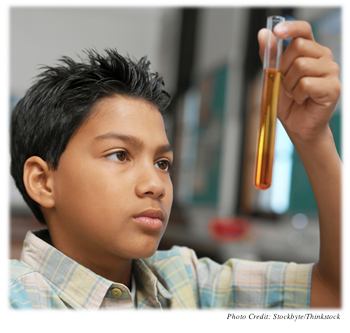
Chapter 1. Brain Development: Middle Childhood
Synopsis
Brain Development: Middle Childhood
Author
S. Stavros Valenti, Hofstra University
Synopsis

In this activity, you will observe illustrations and animations of brain development during middle childhood (ages 6 through 11). The brain adds myelin to the connecting fibers of neurons while also the pruning of synaptic connections occurs. The activity ends with a discussion of the role of experience and the continued development of the prefrontal cortex.
REFERENCES
Kolb, B., & Whishaw, I. Q. (2001). An introduction to brain and behavior. New York: Worth Publishers.
Siegler, R., Deloache, J., & Eisenberg, N. (2006). How children develop. New York: Worth Publishers.
Important Changes in the Middle Childhood Brain

Around the world, children between the ages of 6 and 11 are given more learning opportunities, responsibilities, and independence. One reason for this is that children of this age are better at thinking, planning, and attending.
Children in middle childhood can think logically most of the time as long as the problems are not too abstract, and they can master almost any physical skill that they attempt to learn. They can sit still for a long span of time and focus their attention on a school lesson or a game played with peers. At this age, learning is mostly fun, and mastering skills is not nearly as frustrating as it often was during early childhood.
Why do these changes begin to occur in middle childhood around the world? Clearly, important brain changes are at work.
Slowing of Brain Growth

Sometime between the ages of 6 and 8, the brain grows more slowly in size limited by the closing of the gaps (sutures) between the separate skull parts. By age 10, the brain is 95 percent the size of an adult brain. The number of neurons changes very little between infancy and adulthood. The growth of the brain at this time in life is due to the addition of more dendrites on the neurons and the myelination of the neural fibers.
Play the animation and watch the enlargement of the brain and head during middle childhood.
1.
Which of the following is primarily responsible for the brain’s increase in size during middle childhood?
Brain Maturation in the Prefrontal Cortex
Although the brain grows slowly during middle childhood, important changes are occurring at the microscopic level. The brain continues to mature in two important ways: the addition of myelin to the connecting fibers of neurons and the remodeling (pruning) of synaptic connections. Both of these changes are most pronounced in the prefrontal cortex, the area of the brain most responsible for inhibiting impulsive behavior, putting the breaks on emotional outbursts, focusing attention, goal-setting, and planning.

The Role of Experience

Fine-tuning of neural networks is, in part, a spontaneous maturational process, but the unique life experience of every child is a primary influence on how the brain develops. Synapses that are used frequently tend to be retained while those that are not are lost. All that a child experiences in play, when practicing a musical instrument, or learning the rules of a game lead to a faster, more honed brain. A more efficient brain makes possible the advances in language, thinking, and social behavior that characterize middle childhood.
Assessment: Check Your Understanding

2.
1. More so than younger children, children ages 6 to 11:
Assessment: Check Your Understanding

3.
2. By age 10, the brain is what percent of its adult size?
Assessment: Check Your Understanding

4.
3. During middle childhood, the brain adds myelin to the connecting fibers of neurons, and synaptic connections are pruned.
Assessment: Check Your Understanding

5.
4. What causes remodeling, or pruning, during middle childhood? How is this process different in each individual child?
Congratulations! You have completed this activity.Total Score: x out of x points (x%) You have received a provisional score for your essay answers, which have been submitted to your instructor.